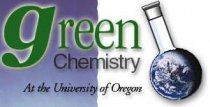University of Oregon junior Dana R. Garves is passionate about green chemistry. She hopes to incorporate its environmentally friendly principles as a chemistry teacher after she graduates.
| Dana talks about green chemistry |
Garves, who graduated from Inglemoor High School in Kenmore, Wash., spent part of her freshman year and all of last year documenting what exposure the UO's Greener Education Materials for Chemists (GEMs) database has experienced on the Web.
GEMs was the creation of her adviser on the project, Julie Haack, the assistant head of the UO's chemistry department, and is part of the UO's green chemistry education network (GCEdNet).
"We found that not only were chemists and education-related people interested in GEMs, but that the general public cared about green chemistry," Garves said. "We found sites like ABC News, MSNBC, FOX and other very accessible, very popular sites were referencing our site."
 The goal of the project, funded by the National Science Foundation and the UO chemistry department, is to raise the visibility of green chemistry educational materials so that educators will adopt them into their curriculum.
The goal of the project, funded by the National Science Foundation and the UO chemistry department, is to raise the visibility of green chemistry educational materials so that educators will adopt them into their curriculum.
 Part of the project involved surveying 150 past participants of the Green Chemistry Education Workshop at the University of Oregon about how they use the GEMs Web site.
Part of the project involved surveying 150 past participants of the Green Chemistry Education Workshop at the University of Oregon about how they use the GEMs Web site.
Garves presented her findings at the 20th Biennial Conference on Chemical Education in Bloomington, Ind., during a poster session on "Green Chemistry Curricula: From Early Adoption to Sustained Integration."
In her poster, Garves wrote: "Our results indicate that the GEMs database is more than a repository of educational materials.
The website is also used to inspire the development of new materials and helps build the case for incorporating green chemistry into the curriculum."
Her research has had a personal impact, Garves said.
"I want to teach high-school chemistry, and what I'm taking away from this experience is that green chemistry can and will make a difference in how students feel about chemistry in general," she said. "If a teacher can apply the science to real-world applications -- like saving the environment or cutting back on energy use -- then students are more likely to feel passionately about the subject. This is something I really feel is necessary to implement so that we can protect the environment."
The UO chemistry department has been among a small group of pioneers turning to and promoting the use of green chemistry at the nation's universities.
The field's growth among educators has had the flavor of a grassroots movement, slowly reaching out and expanding its ideas. UO's efforts to promote green chemistry in academia have gone international in recent years, with chemist Kenneth Doxsee traveling the globe.
"The education community has really lagged behind industry in terms of green chemistry," Haack said, noting the 12-year-old Presidential Green Chemistry Challenge award program, which is managed by the U.S. Environmental Protection Agency and promotes pollution prevention through partnerships with the chemistry community.
Some faculty members around the country, she said, have designed educational materials around these awards to show students how green chemistry can be applied to product development.